On Wednesday, August 3rd, the Jaguar Foundation released a groundbreaking report, “Progressing Gender Representation in UK Dance Music,” which aims to better understand the gender balance among dance music artists and what can be done to improve it.
Launched by U.K. broadcaster, DJ and journalist Jaguar, the foundation’s mission is to foster a more inclusive electronic music community.
“We need this now, more than ever, to better understand the cavernous challenges that women and non-binary artists face every single day and to find positive solutions TOGETHER, so that we can collectively make the dance music industry a safer and more inclusive place,” shared Jaguar in an Instagram post. “We owe it to ourselves and we owe it to future generations to come.”
In collaboration with Sony Music’s Global Social Justice Fund, the Jaguar Organization’s report takes a deep dive into the live sector, streaming, radio and more, delineating impactful data in terms of female and non-binary representation in the industry.
History and culture
When looking at the gender gap in dance music, it’s important to understand why it exists. It’s not a matter of women and non-binary people not wanting to participate in the scene, but instead a matter of cultural and societal norms. Multiple barriers— including the gender pay gap, motherhood and gendered education and career paths—play a role in the lack of female representation in the industry.
“Technology is conventionally seen as the preserve of the man or the male,” explains University of Leeds Professor Alice O’Grady. “It is a male domain, and it’s like girls are just playing at it… Gatekeeping around technology, and women’s relationship to technology, is an issue.”
The irony of the dance music scene is that while marginalized groups played a pivotal role in its creation, the genre has become a predominately white and male scene. House music originated in 1980s Chicago as an underground movement led by Black DJs.
Findings
The live music ecosystem has questions to answer
After taking a deep dive into U.K.’s live music ecosysem (event companies, ticket agents, talent agencies, media companies and record labels) the data show that while there isn’t much of a disparity in the overall gender split, the seniority split does have a larger gap.
From this, we can gather that females are not moving up into positions of authority as often, leaving a male majority of almost two thirds at the top.
Impact of the audience
After examining the U.K. ticketing provider Skiddle, researchers found that 37% of events had over 60% male ticket buyers, with drum & bass, jungle and bassline events showing the most significant male skew. On the flip side of the coin, only 15% of events had over 60% female buyers.
This isn’t because women simply aren’t interested in clubbing. According to the report, which cited Sony Music’s 2021 UK Segmentation Survey, 51.3% of males versus 48.7% of females mentioned clubbing as an interest—a very small difference.
Anecdotally, the more diverse the lineup is, the more diverse the crowd will be.
“If you’ve got an all-white male line-up, that’s gonna attract a lot of white males, and a gay Black man or a Black woman’s not going to feel like they can come to that party,” explains music artist TSHA. “They’re not going to feel like that party is for them.”
Safety and safe spaces
There was an increase in spiking and sexual assault as venues reopened in 2021, so much so that the Night Time Industries Association and Lady of the House prompted an independent inquiry into the laws around spiking. In a recent MIDiA study, two-thirds of female creators identified sexual harassment or objectification as a key challenge.
In an effort to ameliorate workplaces, many artists are very particular about the venues they decide to perform in. Inclusivity or safety riders in contracts are becoming more popular as well, per the report.
“We’re dealing with people who are putting on the night who get too drunk and act inappropriately towards you,” says actress, dancer and singer Riva. “It’s not something you have to deal with as a male or face the same risks. So it becomes so hard to feel secure and feel like you’re going to work but rather you become scared.”
By bringing more women into the live event space, it’s likely that many of these issues would dissipate. The same goes for people of color and other marginalized groups. With more diversity at the top comes fairness across the board.
Female image and the male gaze
A common theme among female artists is a sense of imposter syndrome that stems from hurtful attacks and comments about their appearance.
It’s a catch-22 scenario for female artists. If they are perceived as too attractive, male fans may attribute their success to their looks. But at the same time, women are judged just as much—if not more so—on their appearance than their talent.
Scroll to Continue
Recommended Articles
In MIDiA’s “Be the Change: Women in Music Report 2022,” researchers found that “women creators start out their careers fairly confident (<3 years in the industry) but then confidence issues kick-in at 3-7 years, and worsen until after 13-20 years, at which point they level off.”
Lineups: tokenism vs. genuine representation
The Jaguar Foundation studied 22 festival lineups for electronic and dance artists from 2018-2022. It was found that the average percentage of female and non-binary acts performing comprised just 14% of the lineups in 2018. However, each year the data show more balanced lineups. For 2022, this figure has already risen to 28%.
Larger, more mainstream festivals (those with over 20,000 attendees) have an average of 15% female and non-binary acts on their lineups. On a somewhat better note, smaller, more underground festivals averaged 25%. Men are dominating the lineups of mainstream festivals, which are generally better paid and more prestigious.
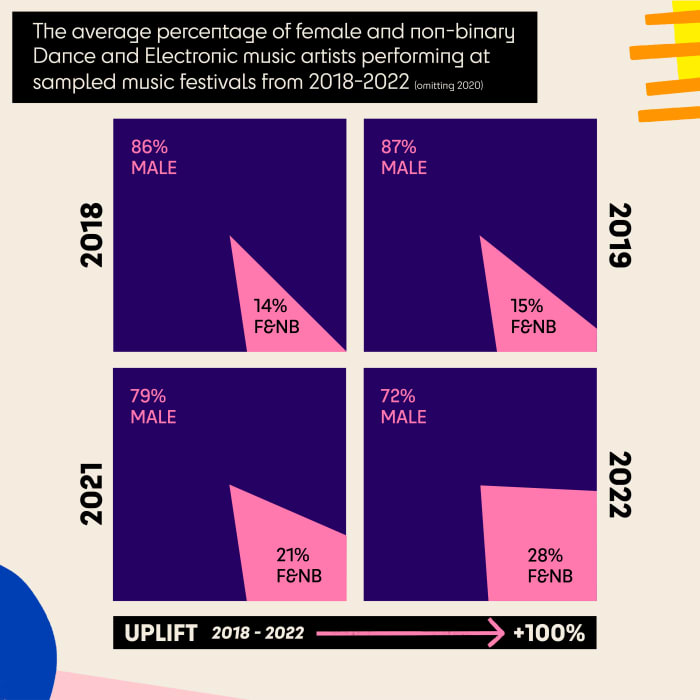
The average percentage of female and non-binary dance and electronic music artists performing at sampled music festivals from 2018-2022.
Gender in the underground vs. the mainstream
To understand gender representation in the mainstream, The Jaguar Foundation researched three areas: charts, radio airplay and playlists.
After analyzing Official Charts Company data for the U.K. from 2020-2022, it was found that just 5% of the tracks analyzed had exclusively female or non-binary artists as the primary, compared to 58% of tracks having exclusively male as the primary artist and feature. Overall, 95% of tracks include a male artist.
Looking at radio airplay, the researchers analyzed a total of 467 songs that appeared in the top 200 airplay tracks across 12 U.K. radio stations that play dance music. It was found that less than 1% of the tracks feature only female or non-binary artists, as compared to 55% of tracks featuring males only. Overall, over 99% of tracks included male artists.
Lastly, the analysts looked at playlists. After studying 23 dance-featuring playlists on Spotify, it was found that 76% of the identified artists were male.
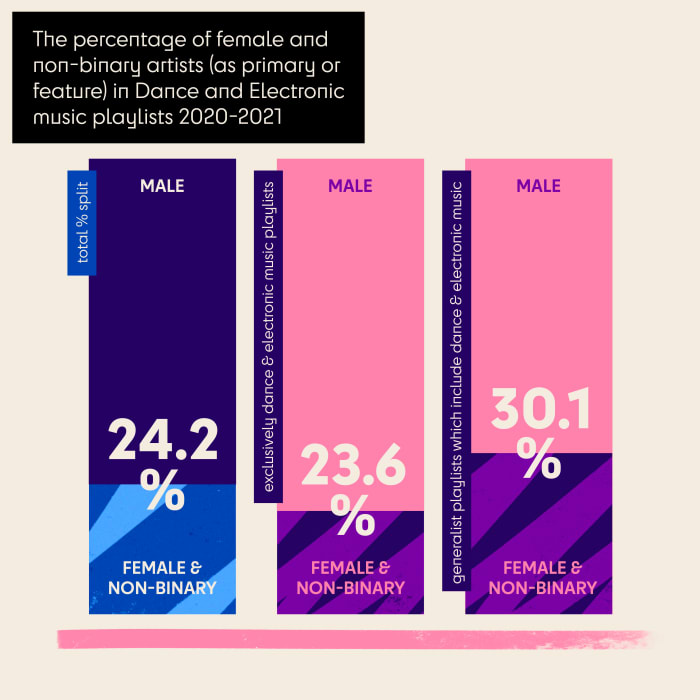
The percentage of female and non-binary artists as primary or feature in dance and electronic music playlists 2020-2021.
You can’t be what you can’t see
From a young age, boys are encouraged to explore technology while girls are typically steered into other avenues. This creates a lack of women and non-binary people in roles like music production and audio engineering.
Regarding executive roles in the industry, there have historically been far fewer women, which means fewer role models for the next generation.
But things seem to be getting better.
“I was one of three women in the office, but now at least 50% of the office are women,” explains Defected Records A&R manager Adrienne Bookbinder. “So in terms of the changes that have occurred over the past seven years, that’s something quite visible.”
Recommendations for Change
To foster positive change, the Jaguar Foundation recommends the following for industry folks, artists and fans.
Industry
- Demystifying dance music: Make dance music more accessible through workshops and initiatives targeted at marginalized groups.
- Flexible working arrangements: Create more adaptable shared parental leave through flexible hours, adequate staff support, remote working, and job shares.
- Support grassroots organizations: Establish industry groups that can help behind the scenes
- What gets measured gets managed: collect and track diversity data even when it’s not a legal requirement. This helps paint a clear picture of the overall industry
- Join AFEM (Association for Electronic Music): A global voice for the electronic music industry where all members have a responsibility to follow their Code of Conduct.
- Accessible music production and DJ resources: From a young age into adulthood, marginalized groups should have access to resources. Full resource list available here.
- Education and awareness of the experience of trans and non-binary people: The burden should not always be on those who identify in this way to explain their experience to others.
Artists
- Consider a safety and inclusion rider: The more contracts that include these riders, the more promoters and venues will have to listen and adapt. An example can be found here.
- Review your lineups and consider your options: If lineups you’re booked for are not inclusive, perhaps have a conversation with the promoter and suggest other potential DJs.
Fans
- Raise your awareness of spaces and lineups: If you see something that seems unfair, unsafe or just doesn’t sit right, make it known. Talk to the promoter, venue manager or security as soon as you can.
- Use the resources section: Found online at TheJaguarFoundation.net/resources, you can learn more about events, collectives, and music career advice.
You can download the full report here.
FOLLOW THE JAGUAR FOUNDATION:
Website: thejaguarfoundation.net
Instagram: instagram.com/thejaguarfoundation
 [flexi-common-toolbar] [flexi-form class=”flexi_form_style” title=”Submit to Flexi” name=”my_form” ajax=”true”][flexi-form-tag type=”post_title” class=”fl-input” title=”Title” value=”” required=”true”][flexi-form-tag type=”category” title=”Select category”][flexi-form-tag type=”tag” title=”Insert tag”][flexi-form-tag type=”article” class=”fl-textarea” title=”Description” ][flexi-form-tag type=”file” title=”Select file” required=”true”][flexi-form-tag type=”submit” name=”submit” value=”Submit Now”] [/flexi-form]
[flexi-common-toolbar] [flexi-form class=”flexi_form_style” title=”Submit to Flexi” name=”my_form” ajax=”true”][flexi-form-tag type=”post_title” class=”fl-input” title=”Title” value=”” required=”true”][flexi-form-tag type=”category” title=”Select category”][flexi-form-tag type=”tag” title=”Insert tag”][flexi-form-tag type=”article” class=”fl-textarea” title=”Description” ][flexi-form-tag type=”file” title=”Select file” required=”true”][flexi-form-tag type=”submit” name=”submit” value=”Submit Now”] [/flexi-form]
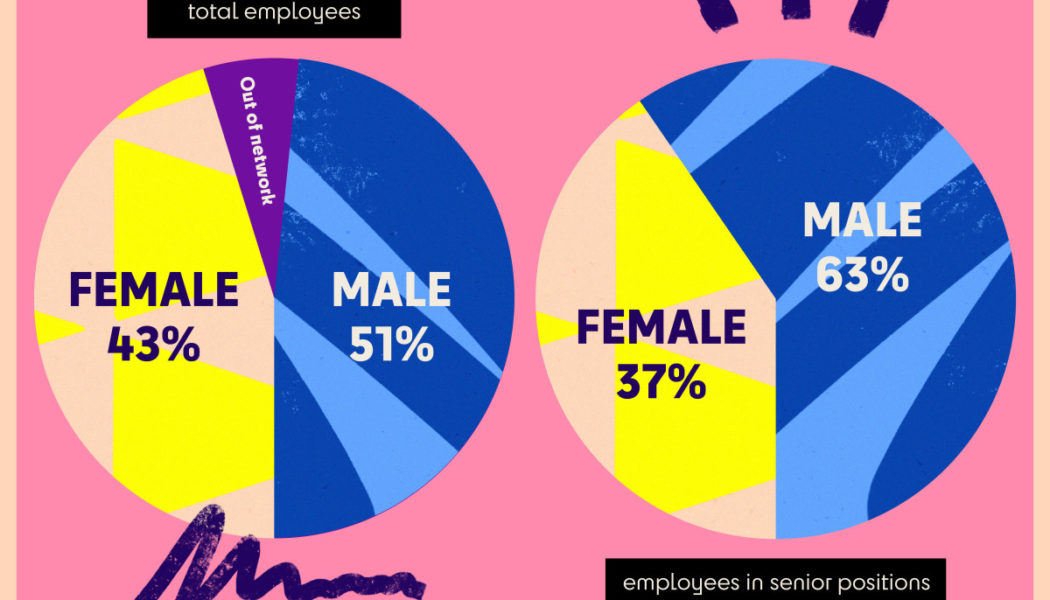
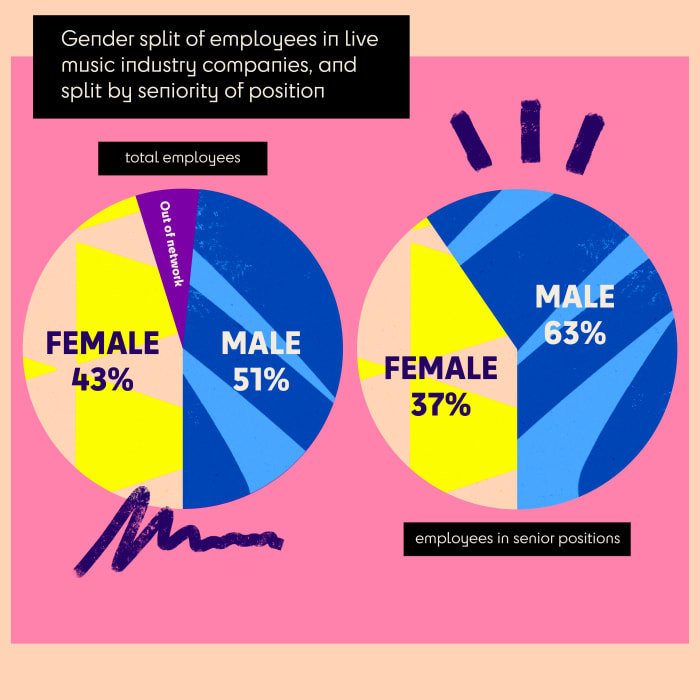
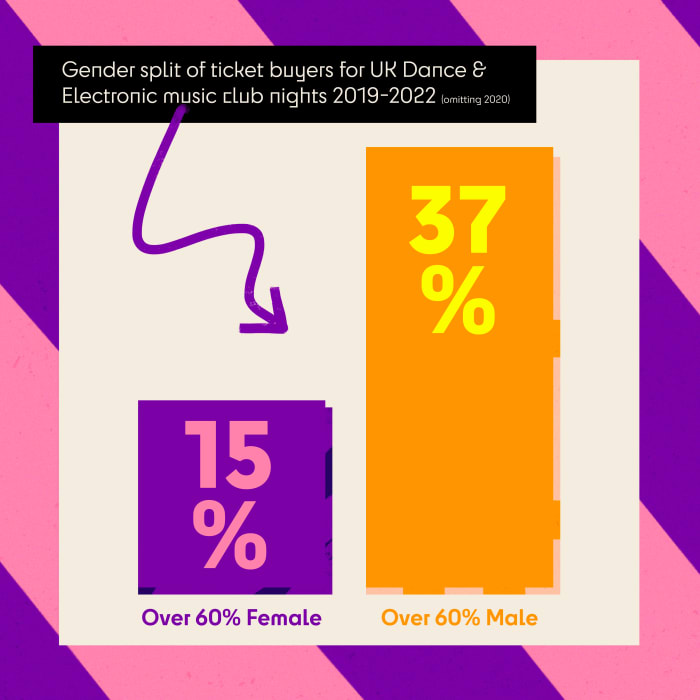

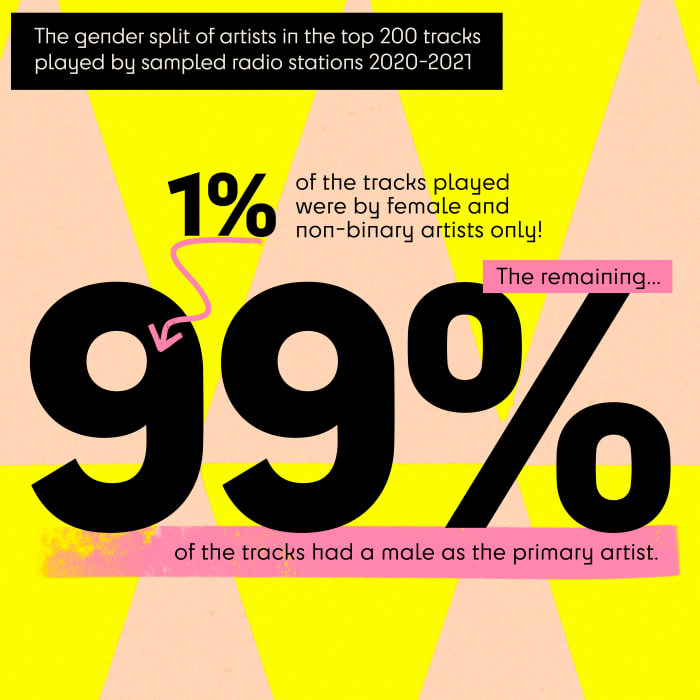
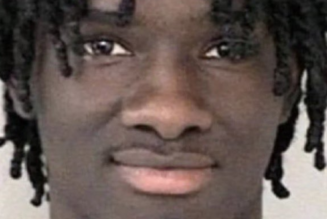
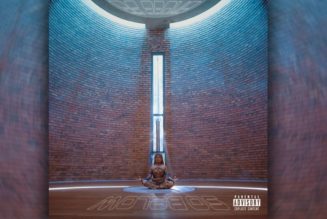
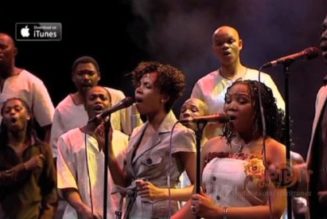
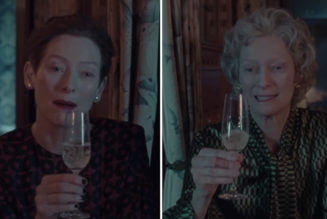
![EDM.com Playlist Picks: Zeds Dead, AC Slater & Slushii [7/1/22]](https://www.wazupnaija.com/wp-content/uploads/2022/07/edm-com-playlist-picks-zeds-dead-ac-slater-slushii-7-1-22-327x219.jpg)




Tagged: Diversity & Inclusion, entertainment blog, FEATURES, Gender, Inclusion, INDUSTRY, music blog, Music Industry, study, Women